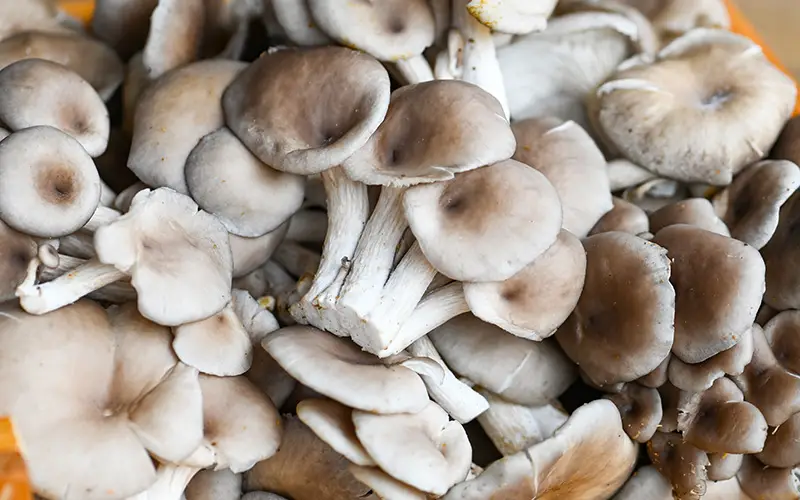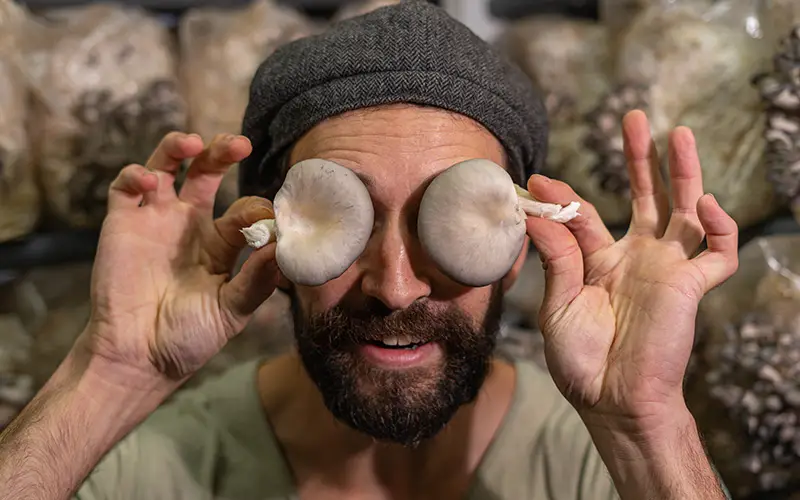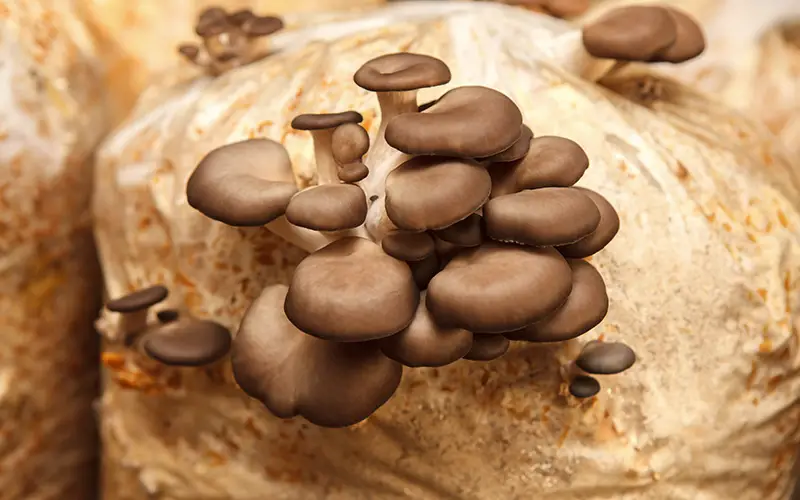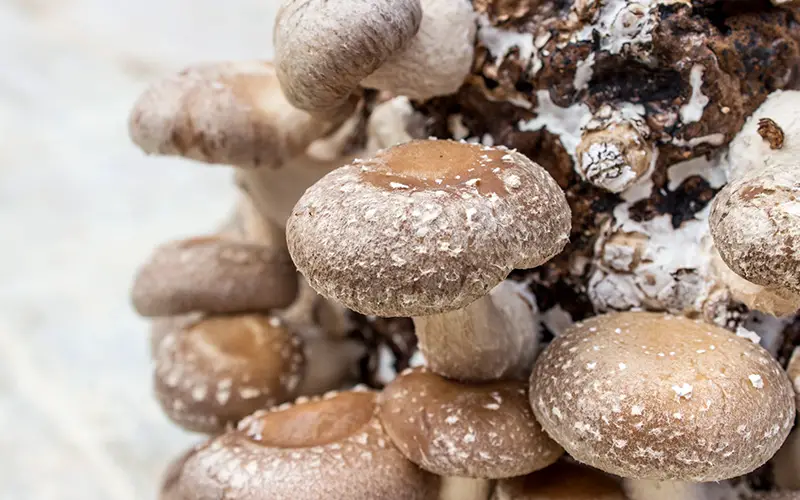Growing mushrooms at home can be challenging, but it doesn’t have to be. One simple and cost-effective approach is using a 5-gallon bucket. This method is not only beginner-friendly but also requires minimal special equipment, making it an attractive option for those looking to cultivate their own mushrooms.
5-gallon bucket setups are versatile, allowing a variety of mushroom species to thrive. By following some basic steps such as drilling holes, preparing the substrate, and maintaining ideal growing conditions, even those with limited experience can successfully grow delicious, healthy mushrooms within their own home.
Combining accessibility with high yields, the 5-gallon bucket technique has become increasingly popular among home growers. Regardless of your specific mushroom variety or growing preferences, this method provides an excellent entry point into the fascinating world of mushroom cultivation.

Choosing the Right Mushrooms
When it comes to growing mushrooms in a 5-gallon bucket, it is crucial to choose the right variety for success. Two popular and beginner-friendly options are oyster mushrooms and lion’s mane mushrooms. These varieties are not only delicious but also grow well in confined spaces and a range of substrate options, making them perfect for a bucket growing environment.
Oyster mushrooms are an excellent choice for bucket growing due to their adaptability and fast colonization rate. They are known for their beautiful fan-like shape and a delicate texture with a mild, earthy flavor. Oyster mushrooms prefer to grow on wood-based substrates like wood chips, aspen woodchips, or sawdust, which are perfect for a 5-gallon bucket setup. This guide provides instructions for growing oyster mushrooms using aspen woodchips and oyster mushroom spawn in a 5-gallon bucket.
Lion’s mane mushrooms are another excellent option for growing in a 5-gallon bucket. Known for their striking appearance, resembling a cluster of icicles or white shaggy hair, lion’s mane mushrooms have a tender texture and unique flavor, often compared to seafood like lobster or crab. Like oyster mushrooms, lion’s mane mushrooms also prefer wood-based substrates, such as hardwood chips, sawdust, or sugarcane mulch. Here’s a helpful article on growing lion’s mane mushrooms in a bucket setup.
When choosing between oyster and lion’s mane mushrooms for your 5-gallon bucket, consider factors like personal taste preference, substrate options, and the desired harvesting speed. Both varieties offer unique flavors and textures while being relatively simple to grow at home. Ultimately, the key to successful mushroom cultivation in a 5-gallon bucket is ensuring optimal conditions, such as proper substrate preparation, moisture levels, and temperature for your chosen mushroom variety.

Preparing the 5-Gallon Bucket
Growing mushrooms in a 5-gallon bucket requires some preparation to ensure the proper conditions for the mushrooms to grow. Two essential steps are drilling holes in the bucket and providing adequate ventilation.
Drilling Holes
First, you will need to drill holes in the 5-gallon bucket for proper airflow and to help with future fruiting of the mushrooms. A quarter-inch drill bit is recommended for this process. According to Organic Garden Tips, at least 35 to 40 holes should be drilled into a 5-gallon bucket. Space the holes evenly around the bucket, approximately 2 inches apart as suggested by Homestead Survival Site.
Ensure to drill holes not only on the sides of the bucket but also on the bottom for excess water to drain. Choosing a step drill for this process can help prevent the bucket from cracking or splitting during the drilling process.
Providing Ventilation
Proper ventilation helps maintain the required humidity levels and oxygen exchange needed for healthy mushroom growth. The holes you drilled in the bucket function as a primary source of ventilation, allowing fresh air to enter and excess carbon dioxide to escape. Additionally, these holes enable some light to penetrate inside the bucket, which is important for the fruiting process.
Make sure to place the prepared 5-gallon bucket in a well-ventilated area, ideally where it is exposed to indirect sunlight or some ambient light. Avoid placing the bucket in direct sunlight or extreme temperatures, as it can negatively affect the growth of the mushrooms.

Substrates and Spawn
Growing mushrooms in a 5-gallon bucket requires the right substrate and spawn to ensure healthy mycelium development and fruitful harvests. This section will discuss the types of substrates best suited for this method and the appropriate spawn to use.
Types of Substrates
Substrate choice is crucial for the successful growth of mushrooms in a 5-gallon bucket. Various substrates can be used, with some of the most popular ones being:
- Hardwood sawdust – a common choice due to its easy availability and effectiveness.
- Aspen wood chips – a suitable option for growing Oyster mushrooms, as demonstrated in this source.
- Coffee grounds – a rich source of nutrients, which some mushroom varieties thrive on.
- Sugarcane mulch – another useful option for a mushroom substrate.
- Cardboard – an unconventional yet effective choice for growing certain mushroom species, like oyster mushrooms.
Choosing the appropriate substrate for the specific mushroom species being grown is essential to support mycelium growth and optimize the harvest.
Oyster Mushroom Grain Spawn
Oyster mushrooms are an excellent choice for growing in 5-gallon buckets due to their adaptability and rapid colonization. Using grain spawn as the seed material for inoculating the substrate is a popular option. It’s advised to use spawn at a rate of five to ten percent to grow oyster mushrooms in a 5-gallon (20-liter) bucket, which equates to 2.5 – 5 lbs (1 – 2.3 kg) of grain spawn for each bucket, as explained by GroCycle.
A higher spawn rate of ten percent allows for quicker colonization, enhancing the chances of successful growth, though using a lower percentage can still yield satisfactory results.

Layering and Inoculation
Growing mushrooms at home using the 5-gallon bucket method is relatively easy and can yield high amounts of oyster mushrooms. One of the critical steps in this process is layering and inoculation. This section will explore the steps involved in preparing the substrate, adding oyster mushroom grain spawn, and creating a comfortable environment for successful bucket cultivation.
Choosing an appropriate substrate is essential for a productive mushroom yield. Suitable substrates for oyster mushrooms include straw, sawdust, or wood chips. Make sure the substrate material is clean, and it is recommended to pasteurize or sterilize it before use. This process helps to eliminate any unwanted microorganisms that may compete with the mushroom mycelium for nutrients.
Once you have prepared the substrate, measure the needed amount of oyster mushroom grain spawn. A spawn rate of 5-10% should be used, which translates to 1-2.3 kg of grain spawn for a 5-gallon (20 liter) bucket.
Begin the layering process by adding a layer of substrate to the bottom of the bucket, followed by a layer of grain spawn. Continue alternating layers until the bucket is filled, ensuring that the topmost layer is substrate. This process allows the spawn to colonize the substrate efficiently and create an environment conducive to mushroom growth.
Close the bucket tightly with a lid and wrap the exterior with a trash bag without tying it, as airflow is essential for supporting the spawning and growth of the mushrooms. Store the wrapped bucket in a cool, dry space such as a closet, attic, or guest room.
Patience is key during the colonization process, which may take several weeks. Monitor the bucket for signs of healthy mycelium growth, such as a uniform white layer covering the substrate and spawning layers. If all conditions are met, your homegrown oyster mushrooms will begin to fruit and thrive using the bucket cultivation method.

Pasteurization and Contamination Prevention
Pasteurization is a crucial step in growing mushrooms in a 5-gallon bucket, as it helps prevent contamination. One effective method of pasteurization involves using hot water to soak the substrate, such as straw, at temperatures between 65-82°C for at least 90 minutes. A propane burner and a large drum can be used to create a hot water bath for this purpose.
Contamination is a common issue when cultivating mushrooms, and it can be caused by various factors such as mold or bacteria. To minimize the risk of contamination, it is essential to:
- Maintain a clean and sterile environment while handling the substrate and inoculating the mushroom culture
- Use pasteurized substrate to discourage the growth of contaminants
- Monitor conditions such as temperature and humidity to ensure optimal growth
In case you spot mold on your mushroom culture, it is advised to spray the surface mold with a 3% hydrogen peroxide solution. This can be purchased over-the-counter, and it is effective in eliminating mold without harming the mushrooms.
Bacterial contamination, such as Bacillus spp. (also known as “wet spot” or “sour rot”), can be a concern as well. To prevent this, mushroom cultivators typically soak their grains for 12 to 24 hours before hydrating or sterilizing them. This process helps impede bacterial growth.
Fruiting and Growing Conditions
Creating High Humidity
To successfully grow mushrooms in a 5 gallon bucket, it is important to create optimal fruiting conditions. One key factor is maintaining high humidity within the bucket. High humidity levels promote the growth and development of mushroom fruiting bodies, as they prefer a moist environment.
There are several ways to increase humidity levels for mushroom cultivation in a 5 gallon bucket. One popular method is to cover the bucket with a plastic bag or sheet, allowing some ventilation while maintaining moisture. This can be achieved by puncturing small holes in the plastic, creating a balance between air exchange and moisture retention(GroCycle).
Spraying with Water
Another method to maintain high humidity levels during the fruiting phase is by using a spray bottle to mist the inside of the bucket with water regularly. Ensuring the mushroom substrate and surrounding environment is consistently moist will enhance fruiting and promote healthy growth. It’s important not to overdo the spraying; a light misting of water will adequately provide the required moisture without soaking the substrate.
When using the spray bottle method, be sure to use clean, dechlorinated water to avoid introducing contaminants or impurities to the growing environment. As mushrooms thrive in high humidity, it’s crucial to avoid pooling water or over-saturation, as these conditions could encourage mold growth and harm the mushrooms(North Spore).
Harvesting and Storage
When it comes to harvesting your mushrooms, timing is crucial. Mushrooms are generally ready to harvest once the cap begins to separate from the stem and the edges of the cap start to curl upwards. Monitor your mushroom growth closely, as they can grow rapidly, sometimes doubling in size within 24 hours.
Before harvesting, make sure your hands and tools are clean to prevent contamination. Carefully twist and pull the mushrooms from the substrate to avoid damaging the remaining mycelium. If some of the substrate comes out with the mushroom, that’s normal, and you can remove it by gently brushing the mushroom or using a knife.
Once harvested, store your mushrooms in a breathable paper bag or a container with a loose-fitting lid in the refrigerator. Avoid using plastic bags, as they can trap moisture and cause your mushrooms to spoil more quickly. Properly stored, most mushrooms will last around one week in the refrigerator. If you have a surplus of mushrooms or want to store them for a longer period, consider options like dehydrating, freezing, or pickling.
After the first harvest, you may continue to grow mushrooms in your 5-gallon bucket by providing optimal conditions for a second flush. This may include adding moisture to the substrate, ensuring proper airflow, and maintaining the ideal temperature. Continue to monitor the progress and harvest any new mushrooms as they mature.
Additional Resources
If you are interested in learning more about growing mushrooms in a 5-gallon bucket, there are plenty of resources available to further your knowledge and experience. Many enthusiasts have shared their insights online, making it easy to find a wealth of information.
One notable resource is YouTube, which offers a variety of video tutorials and guides demonstrating the process of growing mushrooms in buckets. Channels like FreshCap Mushrooms provide step-by-step instructions and helpful tips that will enhance your understanding of mushroom cultivation techniques.
For a more in-depth study, you can visit websites such as GroCycle and Cascadia Mushrooms. These sites offer comprehensive guides that cover various aspects of mushroom growing, including substrate preparation, inoculation, and maintenance of optimal growth conditions. They also provide troubleshooting advice for potential issues that may arise during the process.
Another interesting resource is the Opera web browser, which features a news feed tailored to your interests. By adding “mushroom growing” as one of your favorite topics, you’ll receive regular updates on new techniques, innovations, and ideas from various sources, keeping you informed about developments in the world of mushroom cultivation.
Lastly, don’t forget to engage with fellow mushroom growers in online forums and social media groups. These platforms offer invaluable support and real-world experience from people who have successfully cultivated mushrooms in a 5-gallon bucket. Their firsthand knowledge will be of great benefit as you embark on your own mushroom growing journey.
